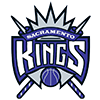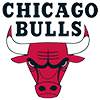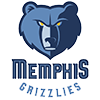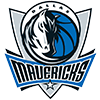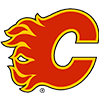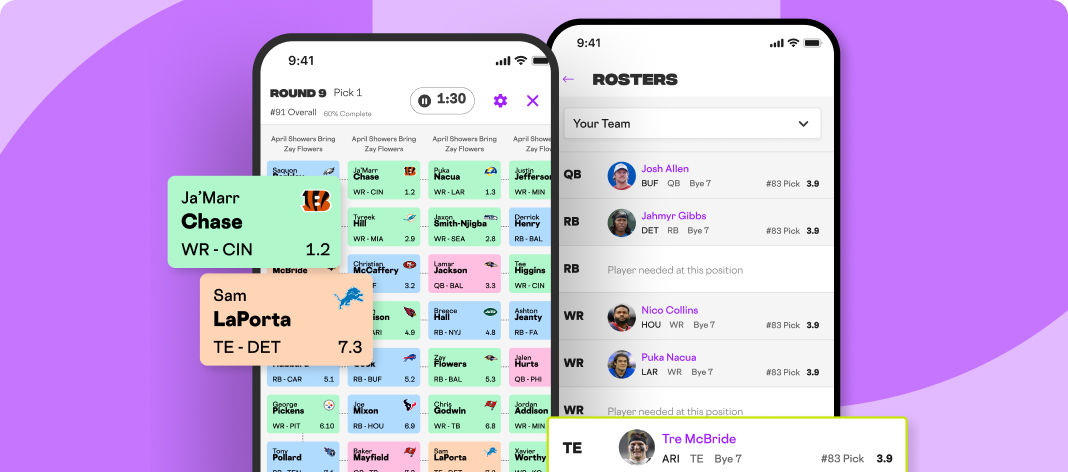As much as it's important to craft a sound dynasty league draft strategy with your offseason drafts, the work of building your team doesn't end there. Working the waiver wire and identifying trade opportunities throughout the year are also important components of an effective broader dynasty league strategy.
This article will identify players whose 2026 fantasy football value stands to rise after the 2025 season yet might be acquired for affordable prices for those who can spare the roster spot in the meantime. While you probably shouldn't get your hopes up for any of these players lifting up your 2025 fantasy squad, it might be preferable to trade for them now when enthusiasm is at a relative low.
The players are listed in descending order of presumed acquisition cost.
Check out the industry-leading fantasy football live draft assistant to get custom fantasy rankings for your league and follow along with a live draft on most major platforms!
Tyler Allgeier, RB, ATL
Honestly, this one is obvious and I'm kind of a fraud for listing Allgeier here at all. If you pursue Allgeier by trade it will likely require parting with some asset of note, because he's one of the top fantasy handcuff backs even in the 2025 season. If the Bijan Robinson owner in your league has Allgeier then it might be particularly difficult to pry him away.
With that said, Allgeier might be worth paying for in a lot of cases, not so much for his 2025 handcuff
As much as it's important to craft a sound dynasty league draft strategy with your offseason drafts, the work of building your team doesn't end there. Working the waiver wire and identifying trade opportunities throughout the year are also important components of an effective broader dynasty league strategy.
This article will identify players whose 2026 fantasy football value stands to rise after the 2025 season yet might be acquired for affordable prices for those who can spare the roster spot in the meantime. While you probably shouldn't get your hopes up for any of these players lifting up your 2025 fantasy squad, it might be preferable to trade for them now when enthusiasm is at a relative low.
The players are listed in descending order of presumed acquisition cost.
Check out the industry-leading fantasy football live draft assistant to get custom fantasy rankings for your league and follow along with a live draft on most major platforms!
Tyler Allgeier, RB, ATL
Honestly, this one is obvious and I'm kind of a fraud for listing Allgeier here at all. If you pursue Allgeier by trade it will likely require parting with some asset of note, because he's one of the top fantasy handcuff backs even in the 2025 season. If the Bijan Robinson owner in your league has Allgeier then it might be particularly difficult to pry him away.
With that said, Allgeier might be worth paying for in a lot of cases, not so much for his 2025 handcuff utility but rather the solid chance that he leaves Atlanta for a starting role elsewhere in free agency following the season. There is some slight risk that the Falcons attempt to re-sign Allgeier as an overqualified backup, but they already have to start thinking about budgeting for Robinson's eventual extension, which will probably be record-setting.
If Allgeier leaves for another team he stands a good chance of serving in a three-down role. Allgeier can play passing downs in addition to withstanding a high-volume, power-heavy rushing workload, but even if he lands in a slight committee as a power specialist he still should provide flex utility with upside for more. As a rookie fifth-round pick Allgeier only needed 481 snaps to generate 1,174 yards from scrimmage.
Not many running backs boast Allgeier's ability to run with both power and big-play ability, so when you throw in Allgeier's ability to play three downs – both in terms of skill set and in terms of volume – there is at least RB2 fantasy upside if Allgeier is playing somewhere else in 2026.
Rachaad White, RB, TB
White appears to be on a downward trajectory in Tampa Bay, losing not only the starting role to Bucky Irving but potentially even backup snaps to Sean Tucker. If Tucker claims the RB2 role in Tampa Bay then it leaves White with basically nothing.
Even so, it would be odd if White weren't more valuable to another team than he is to the Buccaneers. White is limited as a pure runner and this is clearly an issue for Tampa, particularly when Irving and Tucker seem so much better as pure runners. But White is likely one of the very best pass-catching running backs in the NFL, and particularly in this passing-obsessed era of football it would be odd if no team had a use for White, even if only as a pass-catching specialist.
If the Chiefs were to pursue a player to take the role held previously by Jerick McKinnon, for instance, White would likely be a uniquely good fit for that sort of role, and if the details line up right then White could plausibly offer flex-starter utility as soon as the 2026 season, and potentially even sooner if the Buccaneers trade White before then.
White is in the last year of his rookie deal, and his pass-catching production should be interesting to a number of teams. On 185 career targets White has produced a compelling 165 receptions for 1,232 yards and 11 touchdowns. That's an 89.2-percent catch rate at 6.7 yards per target – truly unique pass-catching returns by running back standards.
Ben Sinnott, TE, WAS
Sinnott's rookie year was a disappointment even when granting deference to Zach Ertz, so his long-term projection is objectively worse than it was before his five-catch rookie season. Just because Sinnott's odds are worse doesn't mean he can't still be a hit in the long-term, however – he remains a very good prospect and still projects as a future starter, including potentially in fantasy football.
Sinnott's lack of pass-catching production his rookie year is very plausibly explained by the idea that it was impossible for him to earn route-running playing time over Ertz, who had prior familiarity with Kliff Kingsbury as Arizona's lead slot receiver in Kingsbury's last ~1.5 seasons in Arizona. Similarly, Kingsbury might have simply decided to make Ertz his main slot route runner in 2024 regardless of Sinnott's input.
If anything, the main concern with Sinnott as a prospect was that he might not be a good enough blocker by tight end standards. His rookie year offered reassurance on that point – Sinnott earned 293 snaps specifically as a blocking specialist, which is a meaningful accomplishment given that Ertz played 729 snaps and esteemed blocking specialist John Bates played 487.
The big-picture point here is that Sinnott might already be a better blocker than expected, and as a route runner there's reason to believe he'll take off the second Ertz is out of the way. Ertz drew roughly 18 percent of Washington's targets last year but was slightly below baseline, with his negligible 0.1-percent catch rate surplus probably outweighed by his 0.7-yards per target deficit. In other words, even in Ertz's relatively successful 2024 season there is basis to suggest Washington could do better.
Injuries certainly had something do to with it, but before last year Ertz's efficiency was much worse yet. He'll turn 35 in November, and going back to 2020 Ertz has averaged just 6.1 yards per target. The catch rate of 64.6 isn't any good, either.
Sinnott (6-4, 250) is an excellent athlete (4.68-second 40-yard dash, 40-inch vertical, 126-inch broad jump, 11.05 agility score), and his explosiveness will only contrast more with Ertz's declining state every day. As a fourth-year player Sinnott led Kansas State in receiving yardage, drawing 19.2 percent of the team targets and producing 22.9 percent of their receiving yardage. Sinnott's efficiency stats (64.5 percent catch rate, 8.9 yards per target) easily cleared the K-State baseline, too (61.8 percent completion rate, 7.5 yards per attempt).
If the Sinnott owner in your dynasty league has lost the faith, then the time to pounce could be now. Sinnott's price is only likely to get more expensive as time moves along.
Check out our fantasy football ADP report for a comprehensive tool with live-updated ADP data for multiple league formats and sites.
Parker Washington, WR, JAC
Washington has a somewhat low profile as a humble former sixth-round pick, but his age-adjusted production going back to his Penn State career is excellent and by all accounts he has done well in training camp this year.
Washington should be Jacksonville's primary slot receiver in 2025 – an accommodation resulting from Washington's relative lack of speed – but his fundamentals as a wide receiver are plainly strong. In terms of ball skills and the ability to convert targets into catches, Washington has the stuff of a potential future starter.
Dyami Brown is only on a one-year deal, and if he struggles at any point then Washington should be in a position to capitalize. There's otherwise reason to suspect Washington could play well enough in 2025 to earn a starting role for Jacksonville in 2026.
With all of Brown, Brian Thomas and Travis Hunter primarily playing in space and on the boundary, the Jaguars have a clear need for a wideout who can make in-traffic catches over the middle. There's reason to think Washington will be that guy. Washington won't turn 24 until late March, and through 787 snaps he's converted 72 targets into 48 receptions for 522 yards and five touchdowns (66.7 percent catch rate, 7.3 yards per target).
Isaiah Davis, RB, NYJ
Davis will begin the year third on the Jets depth chart behind Breece Hall and Braelon Allen, so he should be relatively cheap. Davis began the 2024 season behind Allen on the Jets depth chart, too, yet Allen was a dud and by the end of the year Davis had not only closed the gap but provided evidence that he might be equal to or straight up better than Allen.
Even aside from his 21-yard fake punt last year, Davis averaged 5.3 yards per carry on his other 29 attempts. Allen averaged only 3.6 yards per carry with just two touchdowns on his 92 carries. Davis was also more efficient as a receiver, turning his 12 targets into nine receptions for 75 yards and one touchdown (75.0 percent catch rate, 6.3 YPT). Allen, meanwhile caught only 19 of his 27 targets for 148 yards and one touchdown (70.4 percent catch rate, 5.5 yards per target).
Many find Allen aesthetically compelling at 6-foot-1, 235 pounds, but they might be less enchanted if Allen had run a pre-draft 40 time. That Allen declined to run a 40, even on Wisconsin's very fast pro day track, should be taken as a red flag but is instead ignored entirely in most analysis. If you try to locate tape of Allen running in a straight line from defenders in pursuit, you'll find instances of him losing ground to players with documented 4.8 speed. More specifically, you can see former Purdue cornerback Dedrick Mackey hold stride with Allen on at least one long run, and Mackey ran a 4.80 40 at his pro day.
Davis (6-0, 218) is not as imposing as Allen at a glance, but his production from scrimmage might prove better. It certainly helps that, instead of running a likely 4.8 like Allen, Davis ran a 4.57-second 40-yard dash at the combine. If Davis had run his 40 on the Wisconsin pro day track instead it likely would have timed as low as 4.45. Why didn't Allen want to run on that track?
Part of crafting a good in-season dynasty fantasy football strategy involves deviating from the crowd at certain points, and despite the hype pushed by the main crowd at the moment the valuation of Allen is too high and Davis too low. Their odds for season-long success are about equal, yet there's minimal interest in Davis despite all the hype for Allen.
Dominate your fantasy football league this season by exploring our comprehensive draft kit. Packed with expert insights, rankings and strategy tips, the kit features our interactive mock draft simulator to prepare you for every scenario. Streamline your draft-day decisions using our printable cheat sheet and stay ahead of the competition with our up-to-date rankings for all formats. RotoWire has everything you need to win. To learn more, subscribe now and start optimizing your roster today!








